EDUC 9705 Assignment 3: Analysis of a Long-Term Learning Program
VerifiedAdded on 2022/12/12
|12
|2568
|176
Report
AI Summary
This report provides a detailed analysis of a long-term learning program designed for a group of 30 girls aged 14-15 attending a rural school in Punjab, India. The program, developed by a teacher, focuses on intercultural learning through the English language. The report examines the program's scope, which includes cultural diversity, ethical values, and language acquisition. The curriculum incorporates movies and novels to enhance engagement, and the program is structured over four weeks with lessons on culture, diversity, ethics, and languages. The assessment scheme includes formative and summative techniques, relevant to the learners. The theoretical framework is based on Implicit Learning Theory (ILT), and the rationale emphasizes the importance of intercultural understanding and English as a global language. The report also includes critical reflections on the program's design, linking decisions to relevant theories and ideas within the field of education.
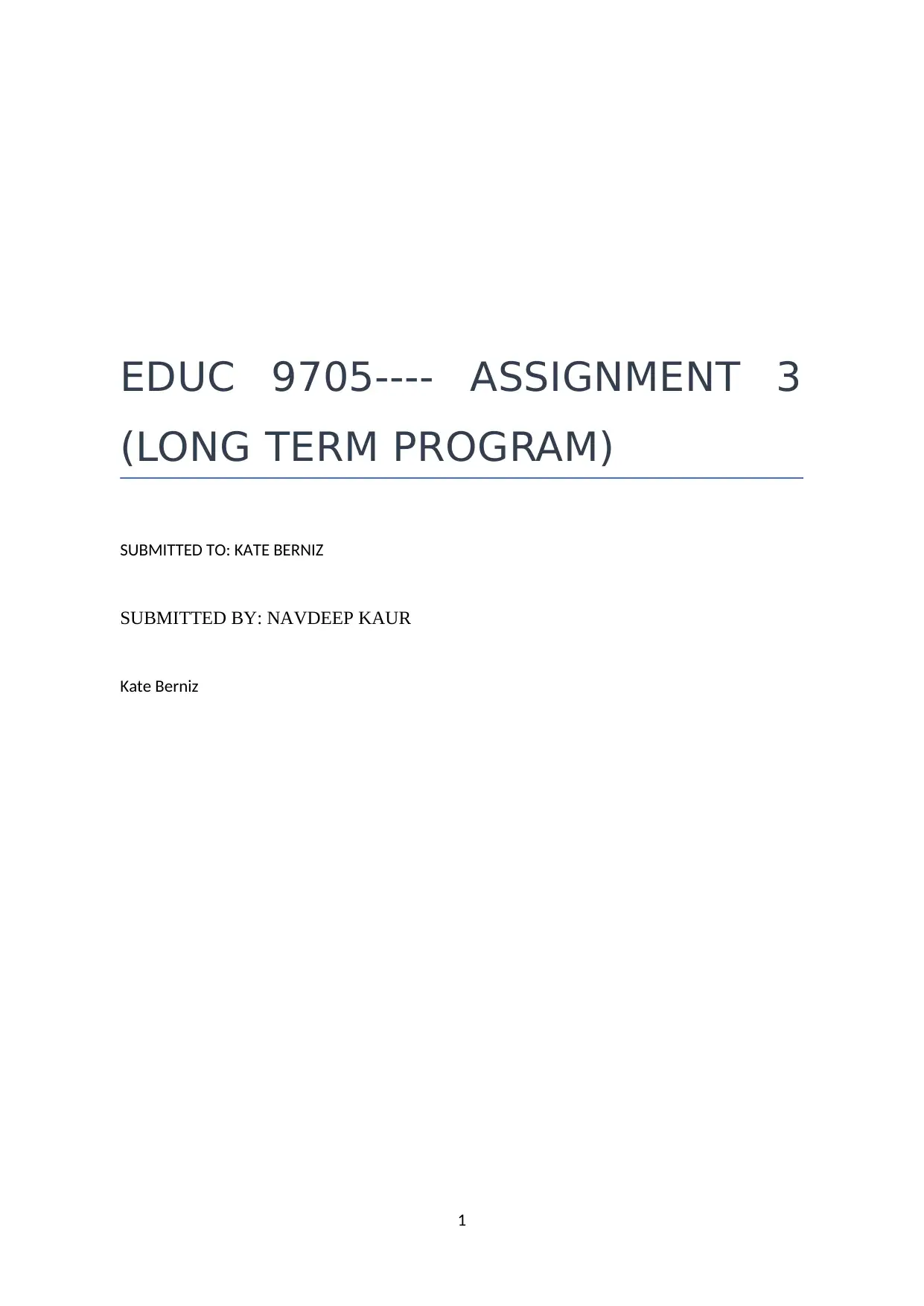
EDUC 9705---- ASSIGNMENT 3
(LONG TERM PROGRAM)
SUBMITTED TO: KATE BERNIZ
SUBMITTED BY: NAVDEEP KAUR
Kate Berniz
1
(LONG TERM PROGRAM)
SUBMITTED TO: KATE BERNIZ
SUBMITTED BY: NAVDEEP KAUR
Kate Berniz
1
Paraphrase This Document
Need a fresh take? Get an instant paraphrase of this document with our AI Paraphraser
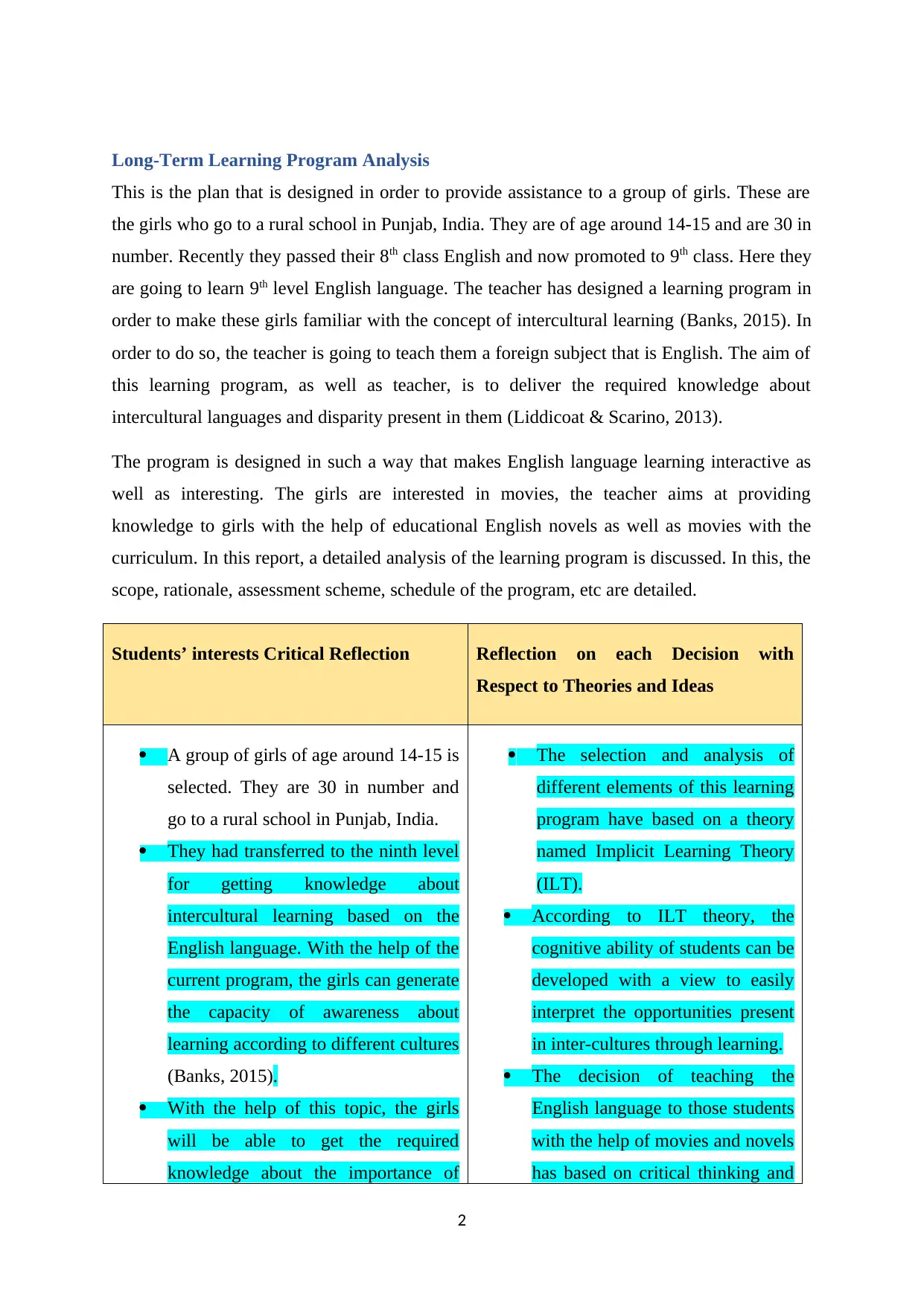
Long-Term Learning Program Analysis
This is the plan that is designed in order to provide assistance to a group of girls. These are
the girls who go to a rural school in Punjab, India. They are of age around 14-15 and are 30 in
number. Recently they passed their 8th class English and now promoted to 9th class. Here they
are going to learn 9th level English language. The teacher has designed a learning program in
order to make these girls familiar with the concept of intercultural learning (Banks, 2015). In
order to do so, the teacher is going to teach them a foreign subject that is English. The aim of
this learning program, as well as teacher, is to deliver the required knowledge about
intercultural languages and disparity present in them (Liddicoat & Scarino, 2013).
The program is designed in such a way that makes English language learning interactive as
well as interesting. The girls are interested in movies, the teacher aims at providing
knowledge to girls with the help of educational English novels as well as movies with the
curriculum. In this report, a detailed analysis of the learning program is discussed. In this, the
scope, rationale, assessment scheme, schedule of the program, etc are detailed.
Students’ interests Critical Reflection Reflection on each Decision with
Respect to Theories and Ideas
A group of girls of age around 14-15 is
selected. They are 30 in number and
go to a rural school in Punjab, India.
They had transferred to the ninth level
for getting knowledge about
intercultural learning based on the
English language. With the help of the
current program, the girls can generate
the capacity of awareness about
learning according to different cultures
(Banks, 2015).
With the help of this topic, the girls
will be able to get the required
knowledge about the importance of
The selection and analysis of
different elements of this learning
program have based on a theory
named Implicit Learning Theory
(ILT).
According to ILT theory, the
cognitive ability of students can be
developed with a view to easily
interpret the opportunities present
in inter-cultures through learning.
The decision of teaching the
English language to those students
with the help of movies and novels
has based on critical thinking and
2
This is the plan that is designed in order to provide assistance to a group of girls. These are
the girls who go to a rural school in Punjab, India. They are of age around 14-15 and are 30 in
number. Recently they passed their 8th class English and now promoted to 9th class. Here they
are going to learn 9th level English language. The teacher has designed a learning program in
order to make these girls familiar with the concept of intercultural learning (Banks, 2015). In
order to do so, the teacher is going to teach them a foreign subject that is English. The aim of
this learning program, as well as teacher, is to deliver the required knowledge about
intercultural languages and disparity present in them (Liddicoat & Scarino, 2013).
The program is designed in such a way that makes English language learning interactive as
well as interesting. The girls are interested in movies, the teacher aims at providing
knowledge to girls with the help of educational English novels as well as movies with the
curriculum. In this report, a detailed analysis of the learning program is discussed. In this, the
scope, rationale, assessment scheme, schedule of the program, etc are detailed.
Students’ interests Critical Reflection Reflection on each Decision with
Respect to Theories and Ideas
A group of girls of age around 14-15 is
selected. They are 30 in number and
go to a rural school in Punjab, India.
They had transferred to the ninth level
for getting knowledge about
intercultural learning based on the
English language. With the help of the
current program, the girls can generate
the capacity of awareness about
learning according to different cultures
(Banks, 2015).
With the help of this topic, the girls
will be able to get the required
knowledge about the importance of
The selection and analysis of
different elements of this learning
program have based on a theory
named Implicit Learning Theory
(ILT).
According to ILT theory, the
cognitive ability of students can be
developed with a view to easily
interpret the opportunities present
in inter-cultures through learning.
The decision of teaching the
English language to those students
with the help of movies and novels
has based on critical thinking and
2
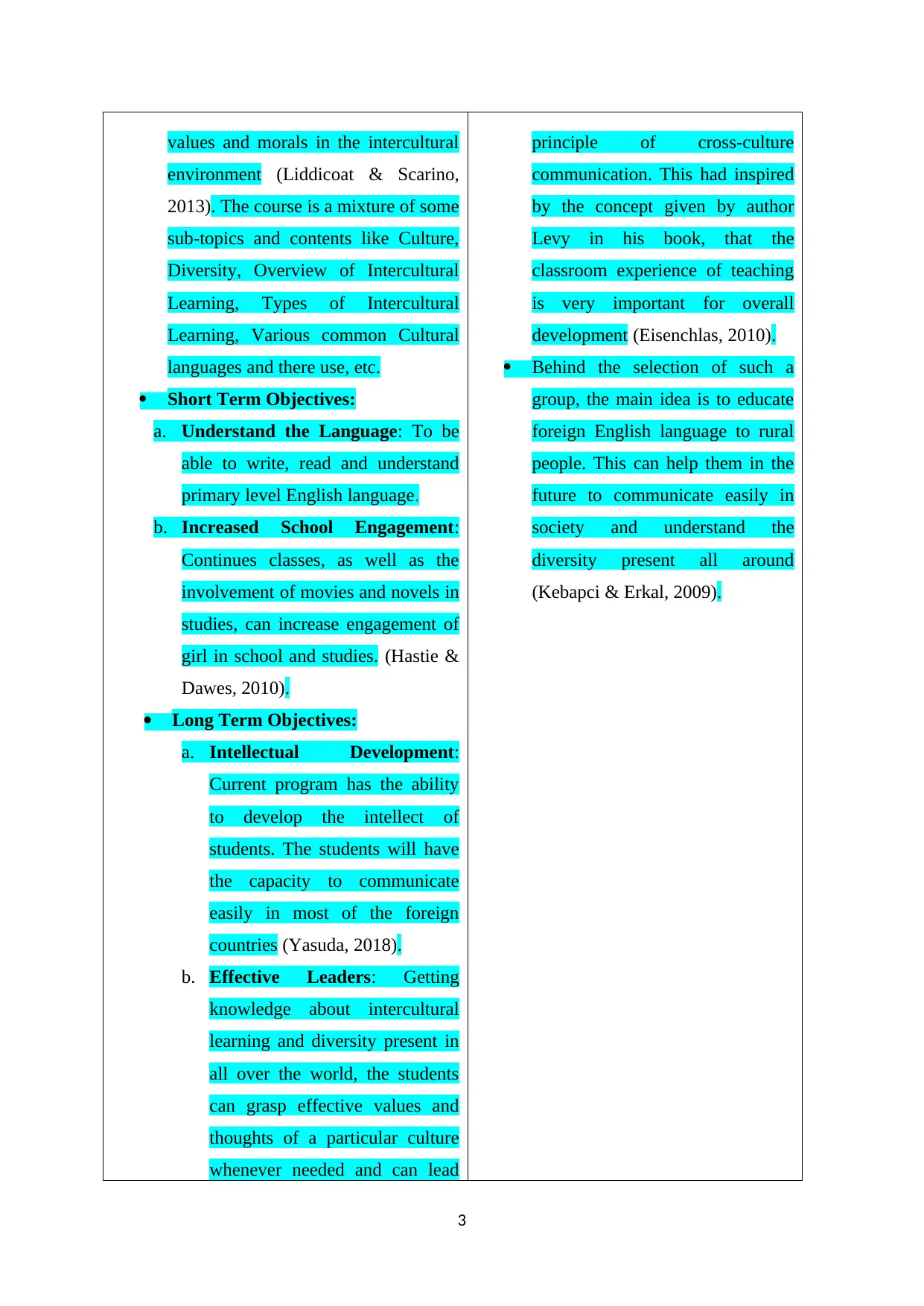
values and morals in the intercultural
environment (Liddicoat & Scarino,
2013). The course is a mixture of some
sub-topics and contents like Culture,
Diversity, Overview of Intercultural
Learning, Types of Intercultural
Learning, Various common Cultural
languages and there use, etc.
Short Term Objectives:
a. Understand the Language: To be
able to write, read and understand
primary level English language.
b. Increased School Engagement:
Continues classes, as well as the
involvement of movies and novels in
studies, can increase engagement of
girl in school and studies. (Hastie &
Dawes, 2010).
Long Term Objectives:
a. Intellectual Development:
Current program has the ability
to develop the intellect of
students. The students will have
the capacity to communicate
easily in most of the foreign
countries (Yasuda, 2018).
b. Effective Leaders: Getting
knowledge about intercultural
learning and diversity present in
all over the world, the students
can grasp effective values and
thoughts of a particular culture
whenever needed and can lead
principle of cross-culture
communication. This had inspired
by the concept given by author
Levy in his book, that the
classroom experience of teaching
is very important for overall
development (Eisenchlas, 2010).
Behind the selection of such a
group, the main idea is to educate
foreign English language to rural
people. This can help them in the
future to communicate easily in
society and understand the
diversity present all around
(Kebapci & Erkal, 2009).
3
environment (Liddicoat & Scarino,
2013). The course is a mixture of some
sub-topics and contents like Culture,
Diversity, Overview of Intercultural
Learning, Types of Intercultural
Learning, Various common Cultural
languages and there use, etc.
Short Term Objectives:
a. Understand the Language: To be
able to write, read and understand
primary level English language.
b. Increased School Engagement:
Continues classes, as well as the
involvement of movies and novels in
studies, can increase engagement of
girl in school and studies. (Hastie &
Dawes, 2010).
Long Term Objectives:
a. Intellectual Development:
Current program has the ability
to develop the intellect of
students. The students will have
the capacity to communicate
easily in most of the foreign
countries (Yasuda, 2018).
b. Effective Leaders: Getting
knowledge about intercultural
learning and diversity present in
all over the world, the students
can grasp effective values and
thoughts of a particular culture
whenever needed and can lead
principle of cross-culture
communication. This had inspired
by the concept given by author
Levy in his book, that the
classroom experience of teaching
is very important for overall
development (Eisenchlas, 2010).
Behind the selection of such a
group, the main idea is to educate
foreign English language to rural
people. This can help them in the
future to communicate easily in
society and understand the
diversity present all around
(Kebapci & Erkal, 2009).
3
⊘ This is a preview!⊘
Do you want full access?
Subscribe today to unlock all pages.

Trusted by 1+ million students worldwide
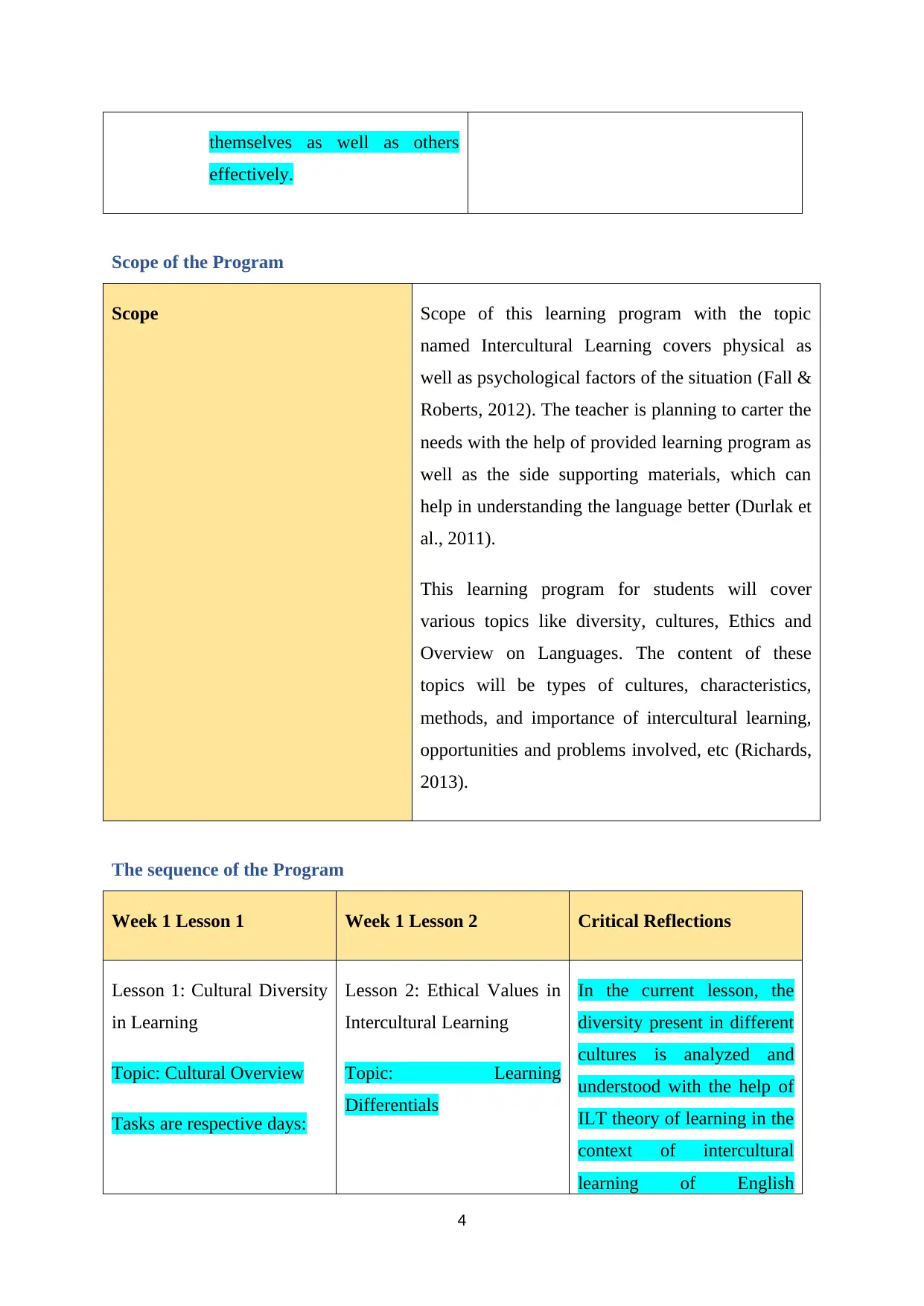
themselves as well as others
effectively.
Scope of the Program
Scope Scope of this learning program with the topic
named Intercultural Learning covers physical as
well as psychological factors of the situation (Fall &
Roberts, 2012). The teacher is planning to carter the
needs with the help of provided learning program as
well as the side supporting materials, which can
help in understanding the language better (Durlak et
al., 2011).
This learning program for students will cover
various topics like diversity, cultures, Ethics and
Overview on Languages. The content of these
topics will be types of cultures, characteristics,
methods, and importance of intercultural learning,
opportunities and problems involved, etc (Richards,
2013).
The sequence of the Program
Week 1 Lesson 1 Week 1 Lesson 2 Critical Reflections
Lesson 1: Cultural Diversity
in Learning
Topic: Cultural Overview
Tasks are respective days:
Lesson 2: Ethical Values in
Intercultural Learning
Topic: Learning
Differentials
In the current lesson, the
diversity present in different
cultures is analyzed and
understood with the help of
ILT theory of learning in the
context of intercultural
learning of English
4
effectively.
Scope of the Program
Scope Scope of this learning program with the topic
named Intercultural Learning covers physical as
well as psychological factors of the situation (Fall &
Roberts, 2012). The teacher is planning to carter the
needs with the help of provided learning program as
well as the side supporting materials, which can
help in understanding the language better (Durlak et
al., 2011).
This learning program for students will cover
various topics like diversity, cultures, Ethics and
Overview on Languages. The content of these
topics will be types of cultures, characteristics,
methods, and importance of intercultural learning,
opportunities and problems involved, etc (Richards,
2013).
The sequence of the Program
Week 1 Lesson 1 Week 1 Lesson 2 Critical Reflections
Lesson 1: Cultural Diversity
in Learning
Topic: Cultural Overview
Tasks are respective days:
Lesson 2: Ethical Values in
Intercultural Learning
Topic: Learning
Differentials
In the current lesson, the
diversity present in different
cultures is analyzed and
understood with the help of
ILT theory of learning in the
context of intercultural
learning of English
4
Paraphrase This Document
Need a fresh take? Get an instant paraphrase of this document with our AI Paraphraser
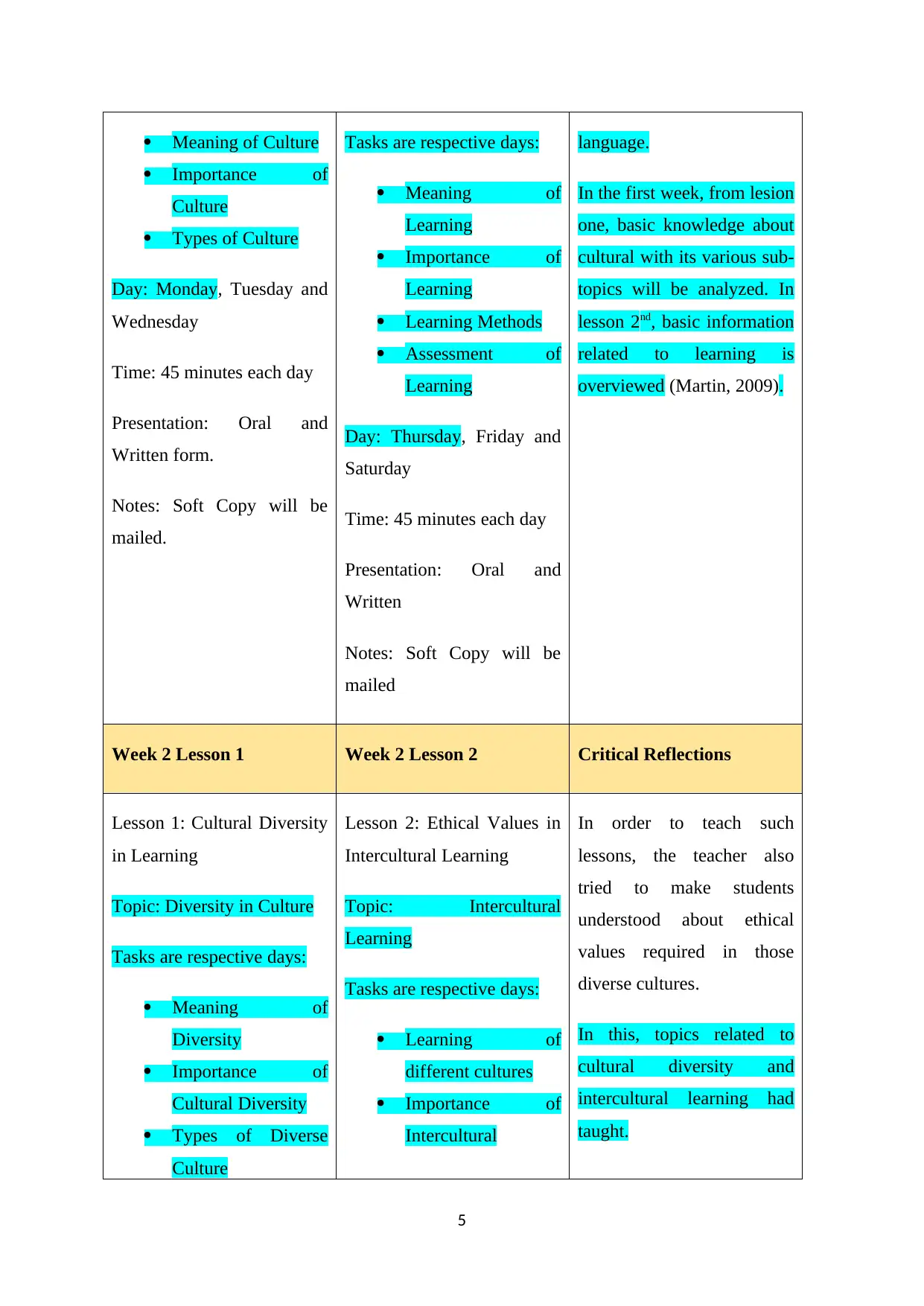
Meaning of Culture
Importance of
Culture
Types of Culture
Day: Monday, Tuesday and
Wednesday
Time: 45 minutes each day
Presentation: Oral and
Written form.
Notes: Soft Copy will be
mailed.
Tasks are respective days:
Meaning of
Learning
Importance of
Learning
Learning Methods
Assessment of
Learning
Day: Thursday, Friday and
Saturday
Time: 45 minutes each day
Presentation: Oral and
Written
Notes: Soft Copy will be
mailed
language.
In the first week, from lesion
one, basic knowledge about
cultural with its various sub-
topics will be analyzed. In
lesson 2nd, basic information
related to learning is
overviewed (Martin, 2009).
Week 2 Lesson 1 Week 2 Lesson 2 Critical Reflections
Lesson 1: Cultural Diversity
in Learning
Topic: Diversity in Culture
Tasks are respective days:
Meaning of
Diversity
Importance of
Cultural Diversity
Types of Diverse
Culture
Lesson 2: Ethical Values in
Intercultural Learning
Topic: Intercultural
Learning
Tasks are respective days:
Learning of
different cultures
Importance of
Intercultural
In order to teach such
lessons, the teacher also
tried to make students
understood about ethical
values required in those
diverse cultures.
In this, topics related to
cultural diversity and
intercultural learning had
taught.
5
Importance of
Culture
Types of Culture
Day: Monday, Tuesday and
Wednesday
Time: 45 minutes each day
Presentation: Oral and
Written form.
Notes: Soft Copy will be
mailed.
Tasks are respective days:
Meaning of
Learning
Importance of
Learning
Learning Methods
Assessment of
Learning
Day: Thursday, Friday and
Saturday
Time: 45 minutes each day
Presentation: Oral and
Written
Notes: Soft Copy will be
mailed
language.
In the first week, from lesion
one, basic knowledge about
cultural with its various sub-
topics will be analyzed. In
lesson 2nd, basic information
related to learning is
overviewed (Martin, 2009).
Week 2 Lesson 1 Week 2 Lesson 2 Critical Reflections
Lesson 1: Cultural Diversity
in Learning
Topic: Diversity in Culture
Tasks are respective days:
Meaning of
Diversity
Importance of
Cultural Diversity
Types of Diverse
Culture
Lesson 2: Ethical Values in
Intercultural Learning
Topic: Intercultural
Learning
Tasks are respective days:
Learning of
different cultures
Importance of
Intercultural
In order to teach such
lessons, the teacher also
tried to make students
understood about ethical
values required in those
diverse cultures.
In this, topics related to
cultural diversity and
intercultural learning had
taught.
5
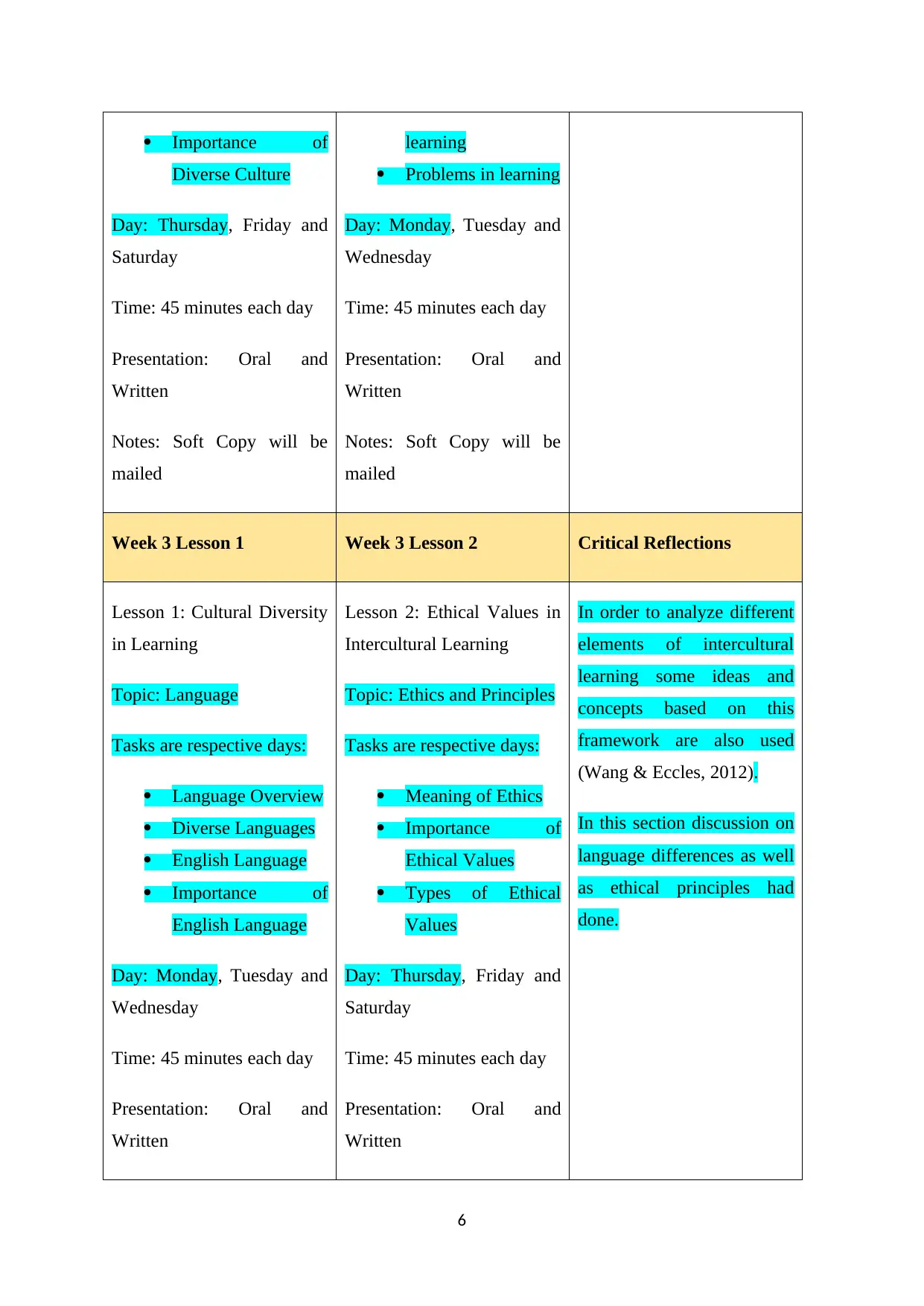
Importance of
Diverse Culture
Day: Thursday, Friday and
Saturday
Time: 45 minutes each day
Presentation: Oral and
Written
Notes: Soft Copy will be
mailed
learning
Problems in learning
Day: Monday, Tuesday and
Wednesday
Time: 45 minutes each day
Presentation: Oral and
Written
Notes: Soft Copy will be
mailed
Week 3 Lesson 1 Week 3 Lesson 2 Critical Reflections
Lesson 1: Cultural Diversity
in Learning
Topic: Language
Tasks are respective days:
Language Overview
Diverse Languages
English Language
Importance of
English Language
Day: Monday, Tuesday and
Wednesday
Time: 45 minutes each day
Presentation: Oral and
Written
Lesson 2: Ethical Values in
Intercultural Learning
Topic: Ethics and Principles
Tasks are respective days:
Meaning of Ethics
Importance of
Ethical Values
Types of Ethical
Values
Day: Thursday, Friday and
Saturday
Time: 45 minutes each day
Presentation: Oral and
Written
In order to analyze different
elements of intercultural
learning some ideas and
concepts based on this
framework are also used
(Wang & Eccles, 2012).
In this section discussion on
language differences as well
as ethical principles had
done.
6
Diverse Culture
Day: Thursday, Friday and
Saturday
Time: 45 minutes each day
Presentation: Oral and
Written
Notes: Soft Copy will be
mailed
learning
Problems in learning
Day: Monday, Tuesday and
Wednesday
Time: 45 minutes each day
Presentation: Oral and
Written
Notes: Soft Copy will be
mailed
Week 3 Lesson 1 Week 3 Lesson 2 Critical Reflections
Lesson 1: Cultural Diversity
in Learning
Topic: Language
Tasks are respective days:
Language Overview
Diverse Languages
English Language
Importance of
English Language
Day: Monday, Tuesday and
Wednesday
Time: 45 minutes each day
Presentation: Oral and
Written
Lesson 2: Ethical Values in
Intercultural Learning
Topic: Ethics and Principles
Tasks are respective days:
Meaning of Ethics
Importance of
Ethical Values
Types of Ethical
Values
Day: Thursday, Friday and
Saturday
Time: 45 minutes each day
Presentation: Oral and
Written
In order to analyze different
elements of intercultural
learning some ideas and
concepts based on this
framework are also used
(Wang & Eccles, 2012).
In this section discussion on
language differences as well
as ethical principles had
done.
6
⊘ This is a preview!⊘
Do you want full access?
Subscribe today to unlock all pages.

Trusted by 1+ million students worldwide
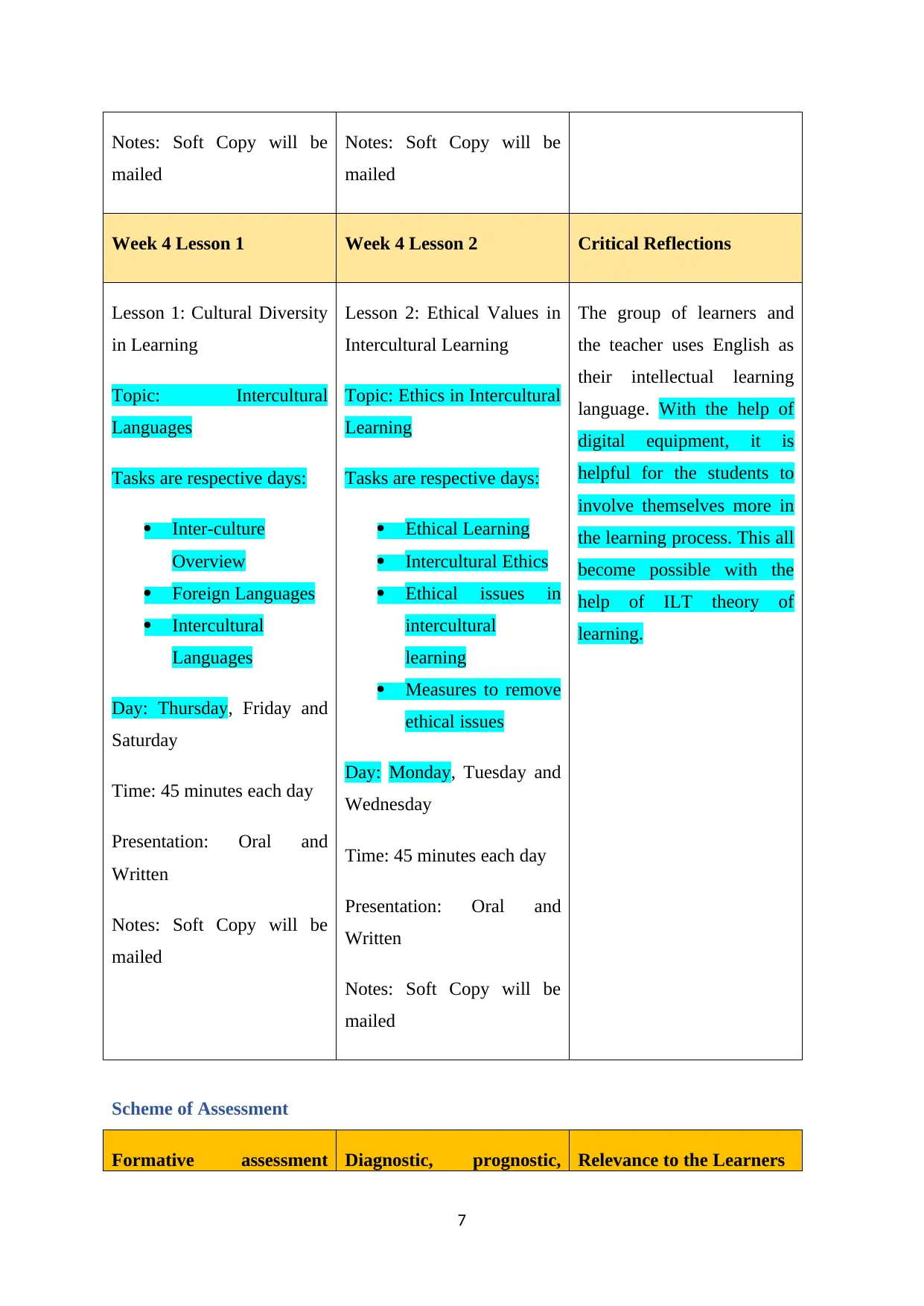
Notes: Soft Copy will be
mailed
Notes: Soft Copy will be
mailed
Week 4 Lesson 1 Week 4 Lesson 2 Critical Reflections
Lesson 1: Cultural Diversity
in Learning
Topic: Intercultural
Languages
Tasks are respective days:
Inter-culture
Overview
Foreign Languages
Intercultural
Languages
Day: Thursday, Friday and
Saturday
Time: 45 minutes each day
Presentation: Oral and
Written
Notes: Soft Copy will be
mailed
Lesson 2: Ethical Values in
Intercultural Learning
Topic: Ethics in Intercultural
Learning
Tasks are respective days:
Ethical Learning
Intercultural Ethics
Ethical issues in
intercultural
learning
Measures to remove
ethical issues
Day: Monday, Tuesday and
Wednesday
Time: 45 minutes each day
Presentation: Oral and
Written
Notes: Soft Copy will be
mailed
The group of learners and
the teacher uses English as
their intellectual learning
language. With the help of
digital equipment, it is
helpful for the students to
involve themselves more in
the learning process. This all
become possible with the
help of ILT theory of
learning.
Scheme of Assessment
Formative assessment Diagnostic, prognostic, Relevance to the Learners
7
mailed
Notes: Soft Copy will be
mailed
Week 4 Lesson 1 Week 4 Lesson 2 Critical Reflections
Lesson 1: Cultural Diversity
in Learning
Topic: Intercultural
Languages
Tasks are respective days:
Inter-culture
Overview
Foreign Languages
Intercultural
Languages
Day: Thursday, Friday and
Saturday
Time: 45 minutes each day
Presentation: Oral and
Written
Notes: Soft Copy will be
mailed
Lesson 2: Ethical Values in
Intercultural Learning
Topic: Ethics in Intercultural
Learning
Tasks are respective days:
Ethical Learning
Intercultural Ethics
Ethical issues in
intercultural
learning
Measures to remove
ethical issues
Day: Monday, Tuesday and
Wednesday
Time: 45 minutes each day
Presentation: Oral and
Written
Notes: Soft Copy will be
mailed
The group of learners and
the teacher uses English as
their intellectual learning
language. With the help of
digital equipment, it is
helpful for the students to
involve themselves more in
the learning process. This all
become possible with the
help of ILT theory of
learning.
Scheme of Assessment
Formative assessment Diagnostic, prognostic, Relevance to the Learners
7
Paraphrase This Document
Need a fresh take? Get an instant paraphrase of this document with our AI Paraphraser
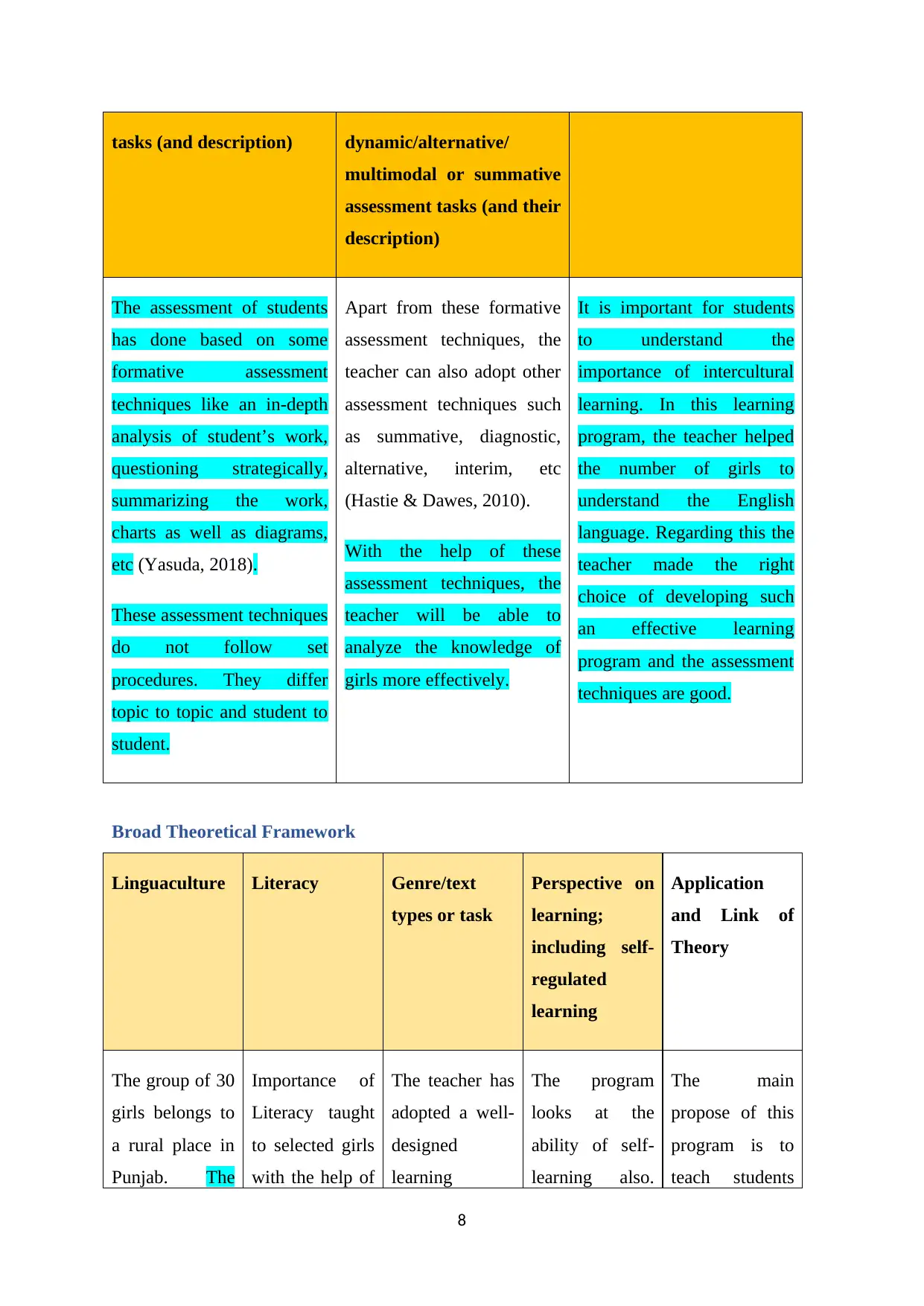
tasks (and description) dynamic/alternative/
multimodal or summative
assessment tasks (and their
description)
The assessment of students
has done based on some
formative assessment
techniques like an in-depth
analysis of student’s work,
questioning strategically,
summarizing the work,
charts as well as diagrams,
etc (Yasuda, 2018).
These assessment techniques
do not follow set
procedures. They differ
topic to topic and student to
student.
Apart from these formative
assessment techniques, the
teacher can also adopt other
assessment techniques such
as summative, diagnostic,
alternative, interim, etc
(Hastie & Dawes, 2010).
With the help of these
assessment techniques, the
teacher will be able to
analyze the knowledge of
girls more effectively.
It is important for students
to understand the
importance of intercultural
learning. In this learning
program, the teacher helped
the number of girls to
understand the English
language. Regarding this the
teacher made the right
choice of developing such
an effective learning
program and the assessment
techniques are good.
Broad Theoretical Framework
Linguaculture Literacy Genre/text
types or task
Perspective on
learning;
including self-
regulated
learning
Application
and Link of
Theory
The group of 30
girls belongs to
a rural place in
Punjab. The
Importance of
Literacy taught
to selected girls
with the help of
The teacher has
adopted a well-
designed
learning
The program
looks at the
ability of self-
learning also.
The main
propose of this
program is to
teach students
8
multimodal or summative
assessment tasks (and their
description)
The assessment of students
has done based on some
formative assessment
techniques like an in-depth
analysis of student’s work,
questioning strategically,
summarizing the work,
charts as well as diagrams,
etc (Yasuda, 2018).
These assessment techniques
do not follow set
procedures. They differ
topic to topic and student to
student.
Apart from these formative
assessment techniques, the
teacher can also adopt other
assessment techniques such
as summative, diagnostic,
alternative, interim, etc
(Hastie & Dawes, 2010).
With the help of these
assessment techniques, the
teacher will be able to
analyze the knowledge of
girls more effectively.
It is important for students
to understand the
importance of intercultural
learning. In this learning
program, the teacher helped
the number of girls to
understand the English
language. Regarding this the
teacher made the right
choice of developing such
an effective learning
program and the assessment
techniques are good.
Broad Theoretical Framework
Linguaculture Literacy Genre/text
types or task
Perspective on
learning;
including self-
regulated
learning
Application
and Link of
Theory
The group of 30
girls belongs to
a rural place in
Punjab. The
Importance of
Literacy taught
to selected girls
with the help of
The teacher has
adopted a well-
designed
learning
The program
looks at the
ability of self-
learning also.
The main
propose of this
program is to
teach students
8
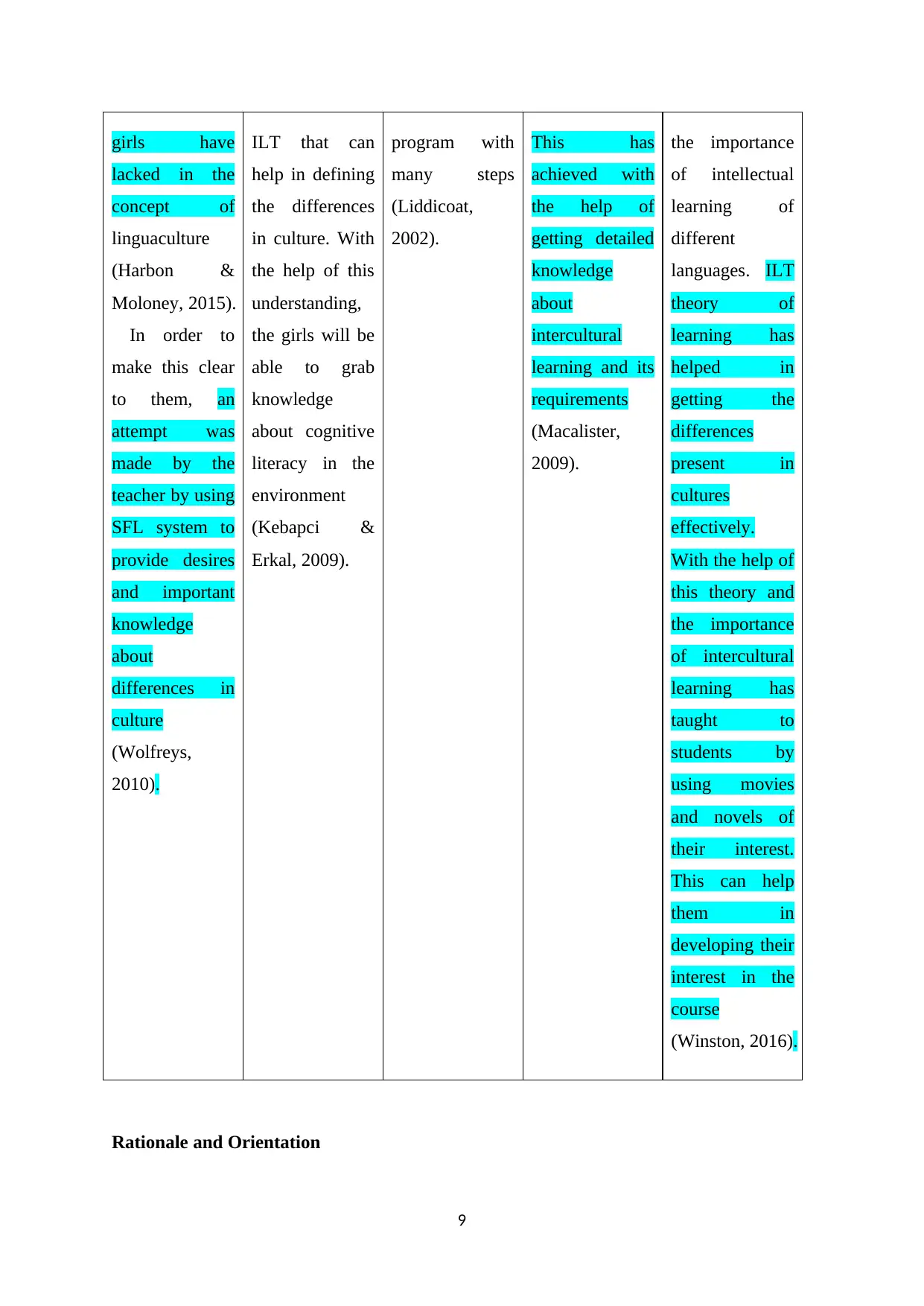
girls have
lacked in the
concept of
linguaculture
(Harbon &
Moloney, 2015).
In order to
make this clear
to them, an
attempt was
made by the
teacher by using
SFL system to
provide desires
and important
knowledge
about
differences in
culture
(Wolfreys,
2010).
ILT that can
help in defining
the differences
in culture. With
the help of this
understanding,
the girls will be
able to grab
knowledge
about cognitive
literacy in the
environment
(Kebapci &
Erkal, 2009).
program with
many steps
(Liddicoat,
2002).
This has
achieved with
the help of
getting detailed
knowledge
about
intercultural
learning and its
requirements
(Macalister,
2009).
the importance
of intellectual
learning of
different
languages. ILT
theory of
learning has
helped in
getting the
differences
present in
cultures
effectively.
With the help of
this theory and
the importance
of intercultural
learning has
taught to
students by
using movies
and novels of
their interest.
This can help
them in
developing their
interest in the
course
(Winston, 2016).
Rationale and Orientation
9
lacked in the
concept of
linguaculture
(Harbon &
Moloney, 2015).
In order to
make this clear
to them, an
attempt was
made by the
teacher by using
SFL system to
provide desires
and important
knowledge
about
differences in
culture
(Wolfreys,
2010).
ILT that can
help in defining
the differences
in culture. With
the help of this
understanding,
the girls will be
able to grab
knowledge
about cognitive
literacy in the
environment
(Kebapci &
Erkal, 2009).
program with
many steps
(Liddicoat,
2002).
This has
achieved with
the help of
getting detailed
knowledge
about
intercultural
learning and its
requirements
(Macalister,
2009).
the importance
of intellectual
learning of
different
languages. ILT
theory of
learning has
helped in
getting the
differences
present in
cultures
effectively.
With the help of
this theory and
the importance
of intercultural
learning has
taught to
students by
using movies
and novels of
their interest.
This can help
them in
developing their
interest in the
course
(Winston, 2016).
Rationale and Orientation
9
⊘ This is a preview!⊘
Do you want full access?
Subscribe today to unlock all pages.

Trusted by 1+ million students worldwide
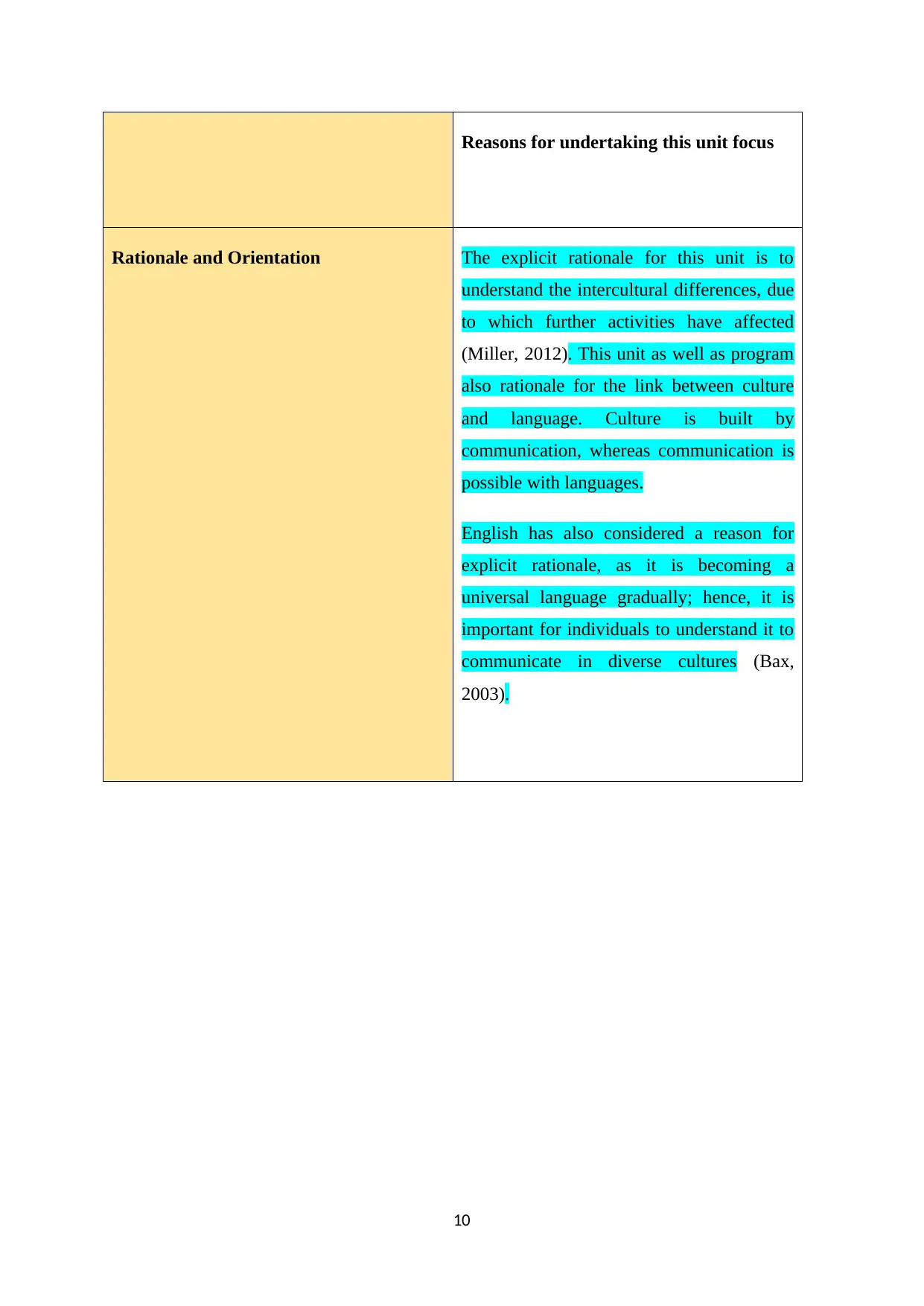
Reasons for undertaking this unit focus
Rationale and Orientation The explicit rationale for this unit is to
understand the intercultural differences, due
to which further activities have affected
(Miller, 2012). This unit as well as program
also rationale for the link between culture
and language. Culture is built by
communication, whereas communication is
possible with languages.
English has also considered a reason for
explicit rationale, as it is becoming a
universal language gradually; hence, it is
important for individuals to understand it to
communicate in diverse cultures (Bax,
2003).
10
Rationale and Orientation The explicit rationale for this unit is to
understand the intercultural differences, due
to which further activities have affected
(Miller, 2012). This unit as well as program
also rationale for the link between culture
and language. Culture is built by
communication, whereas communication is
possible with languages.
English has also considered a reason for
explicit rationale, as it is becoming a
universal language gradually; hence, it is
important for individuals to understand it to
communicate in diverse cultures (Bax,
2003).
10
Paraphrase This Document
Need a fresh take? Get an instant paraphrase of this document with our AI Paraphraser
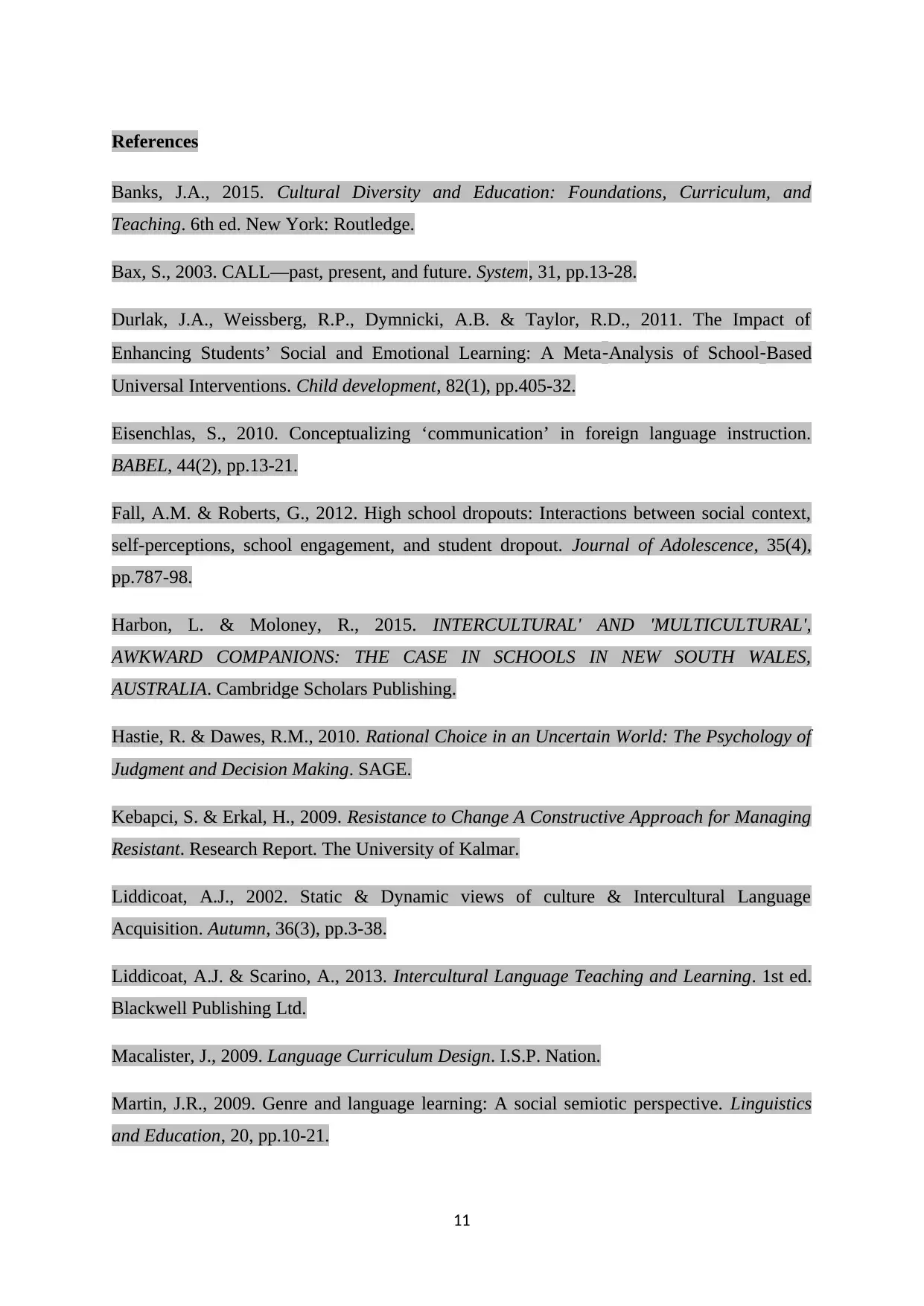
References
Banks, J.A., 2015. Cultural Diversity and Education: Foundations, Curriculum, and
Teaching. 6th ed. New York: Routledge.
Bax, S., 2003. CALL—past, present, and future. System, 31, pp.13-28.
Durlak, J.A., Weissberg, R.P., Dymnicki, A.B. & Taylor, R.D., 2011. The Impact of
Enhancing Students’ Social and Emotional Learning: A Meta‐Analysis of School‐Based
Universal Interventions. Child development, 82(1), pp.405-32.
Eisenchlas, S., 2010. Conceptualizing ‘communication’ in foreign language instruction.
BABEL, 44(2), pp.13-21.
Fall, A.M. & Roberts, G., 2012. High school dropouts: Interactions between social context,
self-perceptions, school engagement, and student dropout. Journal of Adolescence, 35(4),
pp.787-98.
Harbon, L. & Moloney, R., 2015. INTERCULTURAL' AND 'MULTICULTURAL',
AWKWARD COMPANIONS: THE CASE IN SCHOOLS IN NEW SOUTH WALES,
AUSTRALIA. Cambridge Scholars Publishing.
Hastie, R. & Dawes, R.M., 2010. Rational Choice in an Uncertain World: The Psychology of
Judgment and Decision Making. SAGE.
Kebapci, S. & Erkal, H., 2009. Resistance to Change A Constructive Approach for Managing
Resistant. Research Report. The University of Kalmar.
Liddicoat, A.J., 2002. Static & Dynamic views of culture & Intercultural Language
Acquisition. Autumn, 36(3), pp.3-38.
Liddicoat, A.J. & Scarino, A., 2013. Intercultural Language Teaching and Learning. 1st ed.
Blackwell Publishing Ltd.
Macalister, J., 2009. Language Curriculum Design. I.S.P. Nation.
Martin, J.R., 2009. Genre and language learning: A social semiotic perspective. Linguistics
and Education, 20, pp.10-21.
11
Banks, J.A., 2015. Cultural Diversity and Education: Foundations, Curriculum, and
Teaching. 6th ed. New York: Routledge.
Bax, S., 2003. CALL—past, present, and future. System, 31, pp.13-28.
Durlak, J.A., Weissberg, R.P., Dymnicki, A.B. & Taylor, R.D., 2011. The Impact of
Enhancing Students’ Social and Emotional Learning: A Meta‐Analysis of School‐Based
Universal Interventions. Child development, 82(1), pp.405-32.
Eisenchlas, S., 2010. Conceptualizing ‘communication’ in foreign language instruction.
BABEL, 44(2), pp.13-21.
Fall, A.M. & Roberts, G., 2012. High school dropouts: Interactions between social context,
self-perceptions, school engagement, and student dropout. Journal of Adolescence, 35(4),
pp.787-98.
Harbon, L. & Moloney, R., 2015. INTERCULTURAL' AND 'MULTICULTURAL',
AWKWARD COMPANIONS: THE CASE IN SCHOOLS IN NEW SOUTH WALES,
AUSTRALIA. Cambridge Scholars Publishing.
Hastie, R. & Dawes, R.M., 2010. Rational Choice in an Uncertain World: The Psychology of
Judgment and Decision Making. SAGE.
Kebapci, S. & Erkal, H., 2009. Resistance to Change A Constructive Approach for Managing
Resistant. Research Report. The University of Kalmar.
Liddicoat, A.J., 2002. Static & Dynamic views of culture & Intercultural Language
Acquisition. Autumn, 36(3), pp.3-38.
Liddicoat, A.J. & Scarino, A., 2013. Intercultural Language Teaching and Learning. 1st ed.
Blackwell Publishing Ltd.
Macalister, J., 2009. Language Curriculum Design. I.S.P. Nation.
Martin, J.R., 2009. Genre and language learning: A social semiotic perspective. Linguistics
and Education, 20, pp.10-21.
11
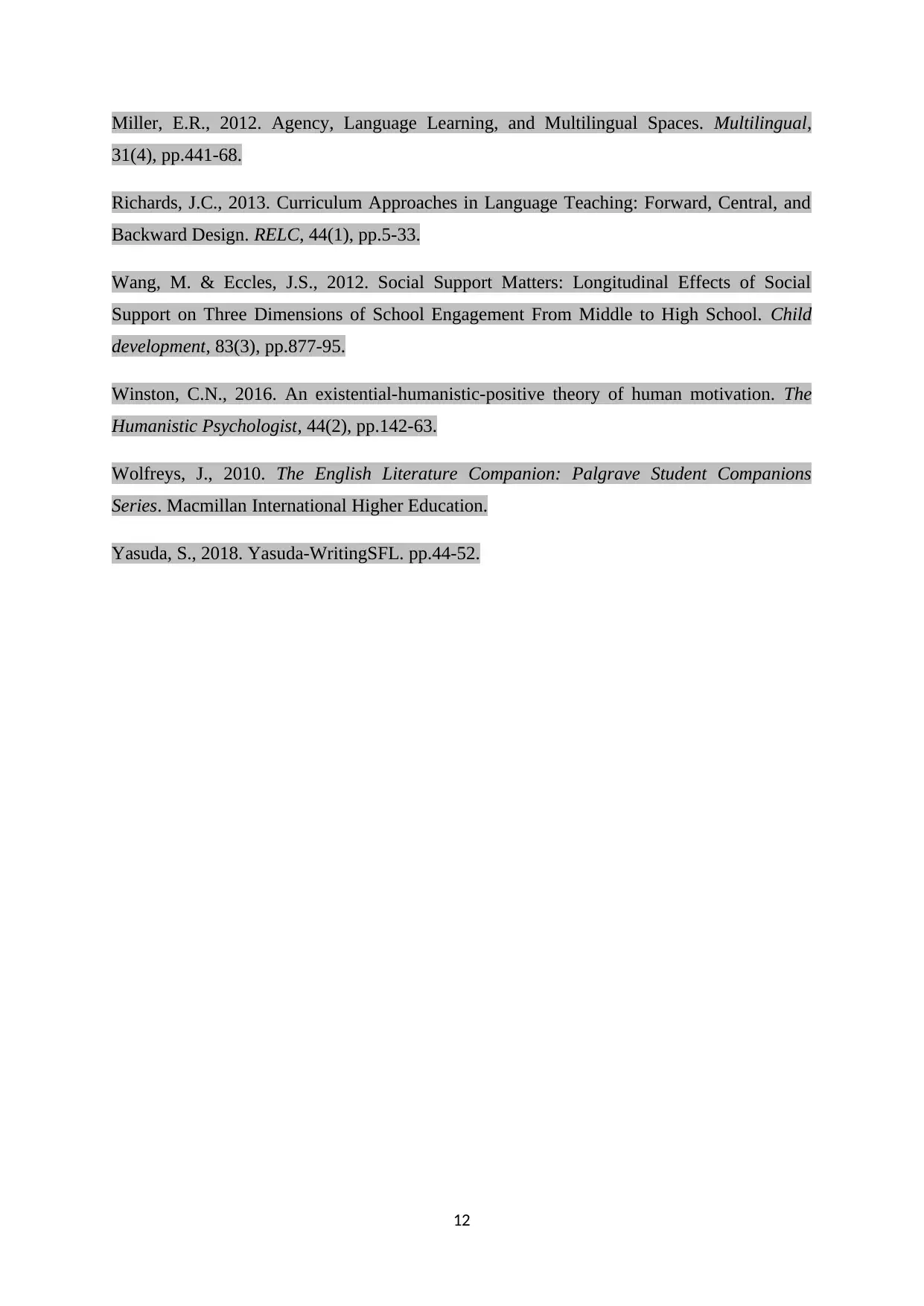
Miller, E.R., 2012. Agency, Language Learning, and Multilingual Spaces. Multilingual,
31(4), pp.441-68.
Richards, J.C., 2013. Curriculum Approaches in Language Teaching: Forward, Central, and
Backward Design. RELC, 44(1), pp.5-33.
Wang, M. & Eccles, J.S., 2012. Social Support Matters: Longitudinal Effects of Social
Support on Three Dimensions of School Engagement From Middle to High School. Child
development, 83(3), pp.877-95.
Winston, C.N., 2016. An existential-humanistic-positive theory of human motivation. The
Humanistic Psychologist, 44(2), pp.142-63.
Wolfreys, J., 2010. The English Literature Companion: Palgrave Student Companions
Series. Macmillan International Higher Education.
Yasuda, S., 2018. Yasuda-WritingSFL. pp.44-52.
12
31(4), pp.441-68.
Richards, J.C., 2013. Curriculum Approaches in Language Teaching: Forward, Central, and
Backward Design. RELC, 44(1), pp.5-33.
Wang, M. & Eccles, J.S., 2012. Social Support Matters: Longitudinal Effects of Social
Support on Three Dimensions of School Engagement From Middle to High School. Child
development, 83(3), pp.877-95.
Winston, C.N., 2016. An existential-humanistic-positive theory of human motivation. The
Humanistic Psychologist, 44(2), pp.142-63.
Wolfreys, J., 2010. The English Literature Companion: Palgrave Student Companions
Series. Macmillan International Higher Education.
Yasuda, S., 2018. Yasuda-WritingSFL. pp.44-52.
12
⊘ This is a preview!⊘
Do you want full access?
Subscribe today to unlock all pages.

Trusted by 1+ million students worldwide
1 out of 12
Related Documents
Your All-in-One AI-Powered Toolkit for Academic Success.
+13062052269
info@desklib.com
Available 24*7 on WhatsApp / Email
![[object Object]](/_next/static/media/star-bottom.7253800d.svg)
Unlock your academic potential
Copyright © 2020–2025 A2Z Services. All Rights Reserved. Developed and managed by ZUCOL.





